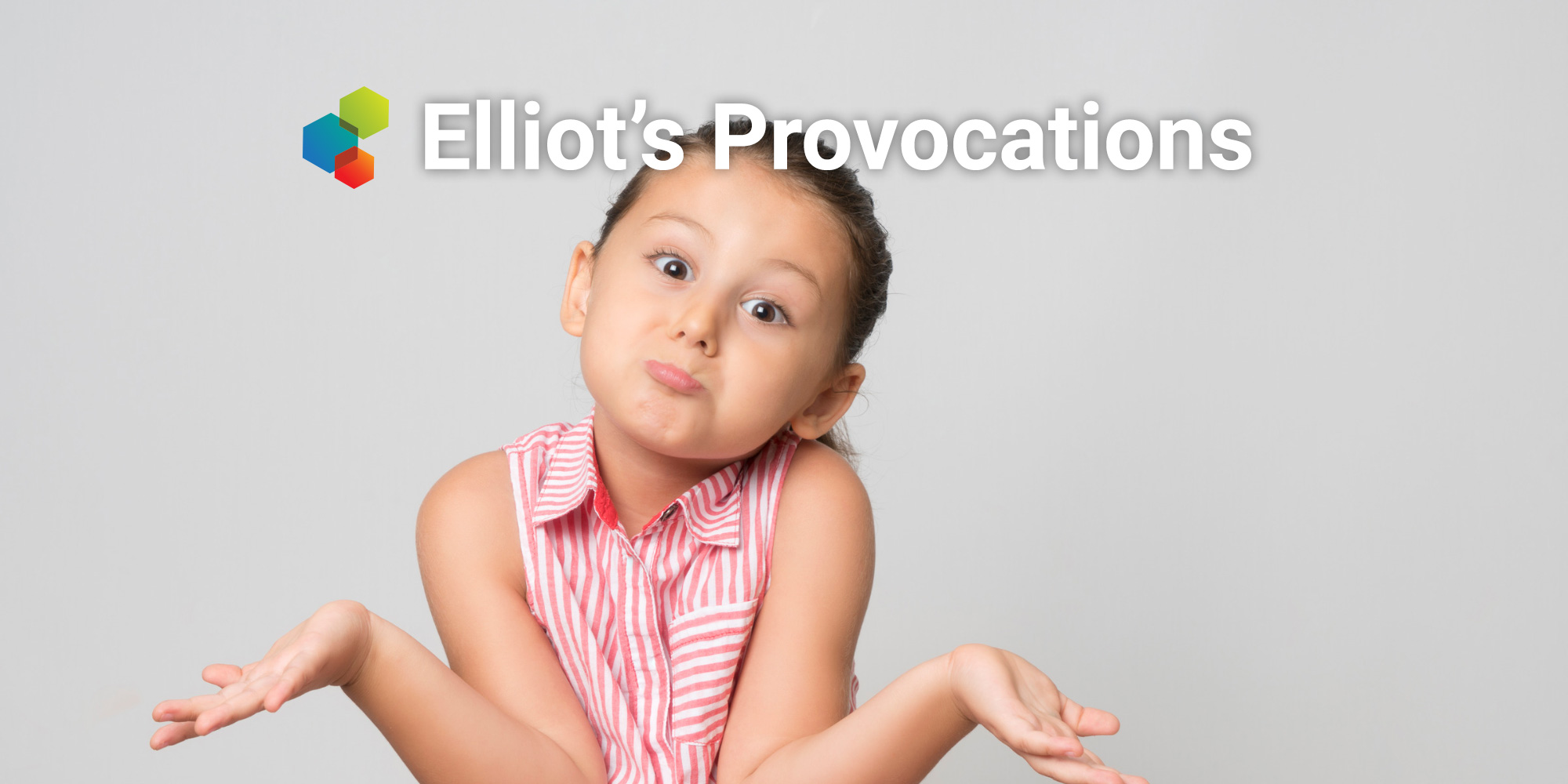Elliot’s Provocations unpacks current events in the early learning world and explores how we can chart a path to a future where all children can flourish. Regarding the title, if you’re not steeped in early childhood education (ECE) lingo, a “provocation” is the field’s term—taken from the Reggio-Emilia philosophy of early education—for offering someone the opportunity to engage with an idea.
We hope this monthly column does that: provocations are certainly not answers, but we hope Elliot’s Provocations helps you pause and consider concepts in a different way.
Guess what? Voters really like the idea of an affordable child care system! In one poll taken after the 2022 midterms, fully three-quarters of voters supported federal action on child care. That included large majorities of all political persuasions. National polls, state polls, it doesn’t matter: child care does great. Even in a hyperpolarized environment like the Build Back Better debate, where there was active opposition, child care provisions consistently polled well even among conservatives.
Yet here we sit amid a buckling child care system, with no prospect of major federal action and only a handful of states making meaningful moves. Why?
One unaddressed political problem is that voter support for child care is exceptionally soft: it doesn’t actually create incentives or consequences for elected officials. [1] Until the sector reckons with that reality and comes up with a strategy to combat it, we will struggle to make true progress. High poll numbers are nice but, until they harden, can threaten to lull us into a sense of complacence that we’ve got the public on our side.
In political communications terms, child care—like many children’s issues—suffers from a problem of salience. Salience is a near-synonym for importance, but it carries more implications. Specifically, salience asks the question ‘how much does this issue impact voters’ behavior?’ Scholars suggest that salience encompasses both how much attention voters (and the media) give an issue and how much weight they assign it when making decisions.
I think a good illustration of the salience issue comes from The West Wing. In one episode, a pollster pushes President Bartlet to support an anti-flag burning amendment because it had overwhelming public support (oh, to be back in February 2000). Later, a different poll expert comments that while accurate, the first pollster asked the wrong question — “he never asked them how much they care.” Although 80% of West Wing Americans were against flag burning, a mere minority said it was important, and barely any said it would impact their vote.
So how much do voters care about child care? Sadly, not a lot.
Child care has a salience problem. A classic way of measuring salience is to ask voters “what do you think is the most important problem” facing the nation. Gallup has been asking this question for years. The economy is almost always at or near the top. Lately, inflation has been headlining. On “non-economic” issues, today’s voters are most concerned with government leadership and immigration.
Where is child care? I can’t tell you because it doesn’t make the chart. Yes, of the nearly 50 options listed, child care doesn’t even get an honorable mention. Its near-peers don’t paint a rosy picture, though. As of January 2023, a mere 2% of voters chose “education” as the most important issue, and less than 1% chose ‘care for the elderly.’ [2]
Pew asks about salience in a different way, and issues like education come out better here. Instead of looking for a sole most important problem, Pew asked whether a variety of issues were a “very big problem,” “moderately big problem,” and so on. Again, inflation reigns at the moment (as of last May, 70% were saying it is a very big problem), with affordability of health care and violence coming in a distant shared second. On the “quality of public K-12 schools,” 39% said it was a very big problem. Again, child care is not on the map.
This out-of-sight, out-of-mind phenomenon (which is tied to child care being cast as an entirely individual responsibility as opposed to a shared social obligation) shows up in popular culture, too. Schools have hit shows like Abbott Elementary. In years past, shows from A.P. Bio to The Wire to Boston Public have shone lights—some comedic, some harsh—on public education. There are award-winning movies about schools and teachers. When’s the last time you saw a fictional TV show or movie about child care? [3]
Vicki Shabo at New America’s Better Life Lab has done work tracking displays of care in entertainment. The recent highlights for child care are unimpressive. They include things like one-off comments in a Grey’s Anatomy episode and passing references in a few other shows. (I also recall child care briefly showing up in Veep, with the punchline being that it was bumped out of a prominent place in Selina Meyer’s presidential campaign announcement; “children are of no value,” complains her political director.) Although child care does get not-infrequent news segments these days, it has also largely been ignored by popular analysis shows. For instance, there have been 261 episodes over 9 seasons of John Oliver’s Last Week Tonight. He has covered everything from sanitation to police in schools. He has done a grand total of zero segments on child care. [4]
What’s to be done? I don’t think we’re magically going to make the public decide child care is the most important issue facing the country, but we can surely help increase its salience. Part of that will involve a deliberate “influencer” strategy. We have to present—in mediums that reach far beyond the echo chamber of college-educated progressives—the case for interdependence, the ways in which child-rearing produces social value and requires social support. [5]
As The Cut writer Kathyrn Jezer-Morton put it, tongue seemingly only half in cheek, “I want artists and celebrities to make inane and tone-deaf viral videos about [child care]. I want Cardi B to demand it on behalf of her fans and Gwyneth to murmur about it on Instagram. I want direct-to-consumer fashion brands to compete for my attention by trying to out-care each other with infographic posts about its necessity.” Imagine the Abbott Elementary for child care. [6] Imagine, I don’t know, Rhianna’s Super Bowl pregnancy reveal with her backup dancers spelling out “Universal Child Care Now.” I can’t claim to have a concrete plan here, but achieving cultural lift is a question that should be getting much more attention than it currently does from child care advocates and philanthropies.
The other needed strategy is to work on political messaging that drives home how much child care is a major cost-of-living and freedom issue, in essence borrowing the existing salience. (Fully tethering child care to education is another option, though that would require a hard turn away from the pre-K/child care split and can be fraught to say the least.)
Embracing that frame requires getting away from complicated schemes with sliding scales and income percentages and subsidy cliffs. Instead, we need to be stating simply and repeatedly: The lack of affordable child care is hurting families. It is hurting American freedom. Child care costs blow a hole in family budgets and reduce American prosperity. It is causing parents to have fewer choices about the number of children they can have and living where they want. Having access to the care you need for your family to thrive should be a right.
There’s no question that child care is higher up on the agenda than it was five years ago. But even the boldest state plans fall far short of the investment needed to hit the trifecta of affordability, compensation and quality. There remains a distinct lack of a mass child care movement.
My point in all of this is that we face as much a cultural problem as a policy one. Jezer-Morton is right when she writes, “politics starts out as storytelling.” We need a better story about child care, one that captures the public’s imagination. We need to turn the potential energy stored up in voters’ hypothetical support for child care into kinetic consequence: then, history suggests, politicians may finally step up.
[1] A related problem, which is for another column, is child care’s relative lack of champions among the rich and powerful who have the ear of elected officials; like it or not (not), that is a key element of how Washington works. [2] By the way, this seems to have happened with all the hoopla around Critical Race Theory. In the end, it moved very few votes. [3] To be sure, there are some absolutely fabulous documentaries about child care! These simply do not have the popular reach I’m talking about, though. [4] He did do a neat segment on paid family leave in 2016, though. [5] That interdependence includes support stay-at-home parents, by the way. [6] For fun, I asked ChatGPT to come up with a plot summary for such a show. Here’s how it did:
“Little Learners” is a comedy series that follows the staff of a child care center in a bustling city. The show focuses on the daily struggles and triumphs of the dedicated teachers and caregivers who work hard to provide a safe, nurturing and educational environment for the little ones in their care.
At the center of the show is Miss Jess, the warm and bubbly director of the center who is beloved by both the children and her staff. She is constantly juggling the demands of running the center while also dealing with the parents who drop off and pick up their kids at all hours of the day.
Miss Jess’s team includes a diverse cast of characters, each with their own unique strengths and quirks. There’s Mr. Tom, the veteran teacher who has seen it all and has a heart of gold; Ms. Sarah, the strict but fair disciplinarian who always keeps the children in line; and Ms. Kim, the bubbly and creative art teacher who helps the kids unleash their inner artists.
The show explores a wide range of topics, from dealing with difficult parents to managing challenging behavior in the children. The teachers must also contend with the constant threat of budget cuts and an ever-changing curriculum, all while trying to provide the best care and education for their little learners.
Throughout the series, viewers will see the teachers and children grow and learn together, forming bonds that will last a lifetime. With plenty of laughs and heartwarming moments, “Little Learners” is a feel-good show that celebrates the joys and challenges of caring for children.




